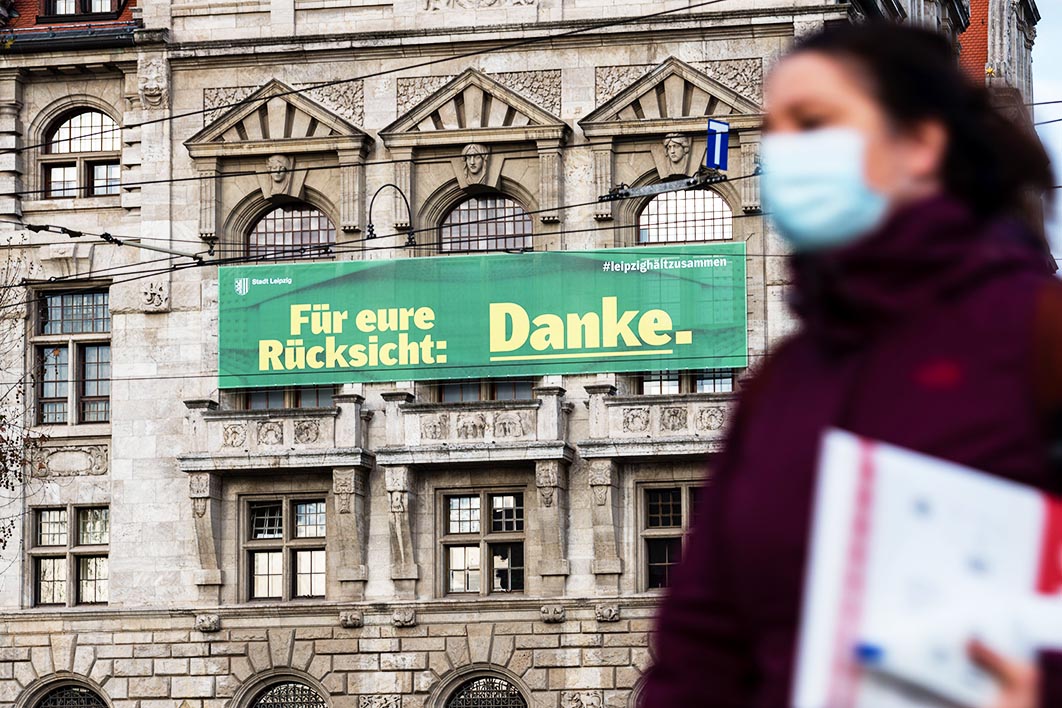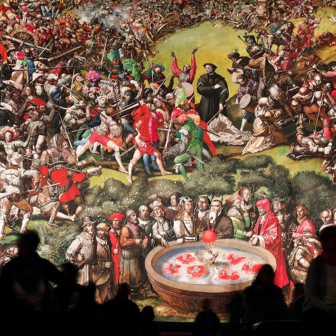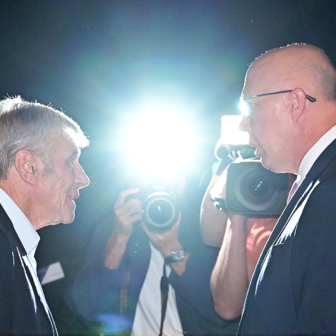Meeting at short notice on Sunday, chancellor Angela Merkel and Germany’s sixteen state premiers finally pulled the emergency brake. From this Wednesday, measures to halt the spread of Covid-19 will be ratcheted up. Most shops will close, even though this means missing out on Christmas business. Most secondary students will start the school holidays early. Companies will be urged to let their staff work from home. Private meetings will be limited to no more than five people from two households.
It’s not hard to see why Germany’s leaders opted for a new hard lockdown. The “lockdown light” that has been in place since 2 November has failed to reduce the number of daily infections. On Friday, the Robert Koch Institute, the agency that tracks infectious diseases, reported 29,875 new infections and 598 new fatalities, the highest daily figures since the pandemic began. According to the DIVI register, which monitors hospital capacity, more than 4500 Covid-19 patients are in intensive care and some hospitals can no longer accept new patients. Most alarmingly, perhaps, the number of clusters of cases in aged care homes is rising rapidly.
“After a temporary stabilisation of case numbers at a higher level in late August and early September, a steep increase in case numbers ensued in October in all federal states,” the Koch Institute reported last Friday. Measures introduced at the beginning of November had failed to cut new cases significantly, with numbers “sharply increasing” over the previous week.
Until recently, Germany had managed the pandemic reasonably well — not as well as East Asian countries but certainly better than its European neighbours. Even as late as the end of September, after infections started to climb again, Germany’s numbers were not particularly alarming compared with those elsewhere in Europe.
On 30 September, according to the European Centre for Disease Prevention and Control, Germany’s cumulative number of cases per 100,000 people over fourteen days was just over thirty, better than each of Germany’s eight neighbouring fellow EU members. Apart from Poland, all had recorded figures in excess of 120.
A month later, Germany’s figure had risen to 195.6 — but even then the country was still doing better than all of its neighbours except Denmark, with the rates in three of them (the Czech Republic, Belgium and Luxembourg) exceeding 1000, and France and the Netherlands both recording a fourteen-day cumulative total of about 750 per 100,000.
By Sunday, though, Germany’s figure had climbed to 334.9, significantly worse than the equivalent figures for France and Belgium. Immunologists agree about the success of the far-reaching restrictions introduced by France and Belgium, like those of other European countries that experienced exponential rises of infections in September and October. By contrast, Germany’s restrictions during November were too weak: while bars and restaurants, and cinemas and theatres were closed, shops remained open, as did schools and childcare centres.
Angela Merkel can’t be blamed for those half-hearted measures. She has long argued that the coronavirus needs to be taken seriously and reportedly wanted stricter restrictions as soon as it became clear that the “lockdown light” hadn’t had the desired effect. She was uncharacteristically emotional last Wednesday when she warned in parliament that too many contacts over the following fortnight might make the coming festive season “the last Christmas with the grandparents.”
Part of the explanation for the slow response to the latest surge lies in the country’s federal system of government. Although Merkel wanted tougher measures, she had failed to convince all of the state premiers. It is their governments that are responsible for imposing and, with local councils, implementing such measures, and they preside over different infection rates and intensive care capacities. The fact that the premiers of the most populous states, Markus Söder of Bavaria and Armin Laschet of North-Rhine Westphalia, have championed diverging approaches throughout the pandemic — not least because they are both vying to succeed Merkel as chancellor — hasn’t helped.
But state–state and federal–state rivalries don’t entirely explain the dithering. The state governments’ fear has been that stricter measures would be met with popular anger.
At first sight, such an explanation seems counterintuitive. Most Germans have long supported a decisive response to the pandemic and have endorsed the government’s handling of the crisis, including the imposition of a strict lockdown earlier in the year. An opinion poll conducted last Thursday, three days before the announcement of tougher measures, showed that 49 per cent of those surveyed wanted more restrictions while only 13 per cent considered existing restrictions excessive. And Merkel’s popularity, and the approval rate for her Christian Democrats, has been exceptionally high since the beginning of the pandemic.
At the same time, polls suggest that the far-right Alternative für Deutschland, or AfD, which has opposed all measures to contain the virus, would fall short of its performance in the 2017 federal election (when it scored 12.6 per cent of the national vote), never mind attract the kind of support it enjoyed a year ago, when one in five surveyed Germans said they would vote for it.
To understand why federal and state governments didn’t heed the almost unanimous advice of the medical experts and impose more drastic measures earlier, we need to go back to the Merkel government’s response to the influx of refugees from Syria in 2015. Or rather, we need to look at how that crisis is remembered, particularly within Merkel’s party, but also among other German politicians outside the AfD.
A powerful narrative says that it was a mistake to open the country’s borders that year, thereby alienating a sizeable minority of Germans opposed to an ethnically and culturally diverse Germany while irritating a majority who didn’t think that the loosening of border controls was justified. For those who have embraced this narrative, polarisation and the rise of the AfD — which in 2017 became the first party of the far right since 1953 to be represented in the Bundestag — have been more traumatic than any other event in reunified Germany’s short history.
This account tends to overlook three facts. First, the government didn’t open Germany’s borders in 2015; rather, it decided not to close them (and not to defend them in any way that echoed the pre-1989 German Democratic Republic’s defence of its border with West Germany by shooting people trying to cross it). Second, polls at the time revealed that a majority of Germans approved of the Merkel government’s response to the refugees. Many may later have changed their minds, but a clear majority still agrees that Germany has an obligation to provide sanctuary for people fleeing war or persecution. Finally, those who voted for the AfD in 2017 hadn’t suddenly become opposed to migration, or to living in a multicultural society, and hadn’t suddenly developed a longing for an authoritarian political leader. Rather, in 2017, it made sense to them to vote for a party that seemed to represent their views.
But whether the facts get in the way of the story is irrelevant. The key thing is that it is held to be true. For many of those who believe the narrative, a repeat or prolongation of the trauma associated with the rise of the AfD must be avoided.
You might imagine that Christian Democrats would want to solve this dilemma by adopting the policy positions of the AfD to try to make it disappear. But Germany’s post-Auschwitz identity works against a rapprochement between centre-right conservatives and the AfD because large sections of the latter are considered ideologically close to the Nazis. This contrasts with countries like Denmark, Austria and the Netherlands, where centre-right or centre-left politicians have espoused positions on refugees and migration that were previously owned by the far right.
Also working against any rapprochement is the fact that past attempts by the Christian Democrats to neutralise a far-right party by adopting its vocabulary or policies have backfired. Ahead of the 1992 state election in Baden-Württemberg, for example, the Christian Democrats moved to the right to attract potential voters from the extremist Republikaner, a precursor of the AfD. The strategy failed miserably: the Republikaner won 10.9 per cent of the vote and the Christian Democrats shed 9.4 percentage points of support compared with the previous state election.
More recently, ahead of the Bavarian state elections in 2018, the Bavarian sister party of the Christian Democrats, the Markus Söder–led Christian Social Union, or CSU, attempted to mimic the AfD’s rhetoric, particularly in relation to asylum seekers. But Söder soon realised that he risked losing more votes to the Greens (because many Christian conservatives were appalled by that kind of rhetoric) than could be gained from potential AfD voters. He changed tack, won the election, and is now a good bet to be the next chancellor, leading a coalition of Christian Democrats and Greens.
This leaves Christian Democrats, in particular, in a quandary. They would like to keep the AfD small (or ideally make it disappear altogether) by wooing potential AfD voters, but without appearing to embrace AfD positions. So they have made do with telling AfD supporters that their concerns are legitimate and are being taken seriously, hoping to thereby avoid provoking the anger of the people who responded so strongly to the refugees.
For the AfD, the pandemic has been disastrous in the sense that it has pushed asylum seekers, who were no longer front-page news anyway, further into the background. But the current crisis has also provided an opportunity for the party. Having initially criticised the government for doing too little, too late, the AfD proceeded to lambast the government for doing too much.
The change of heart had much to do with the emergence during spring of a motley bunch of groups — New Agers, anti-vaxxers and others — that considered the government’s measures an overreaction and didn’t accept the science that informed them. The AfD and other groups on the far right tried, often very successfully, to harness this growing movement. AfD politicians ridiculed face masks, argued against closing schools and businesses, suggested Covid-19 was no worse than the flu, alleged that the government would force the entire population to vaccinate, claimed that restrictions to halt the disease amounted to a suspension of civil liberties and a breach of privacy, and organised demonstrations to channel fear and anger.
The government was taken by surprise when thousands — and sometimes tens of thousands — protested. Because the anger was reminiscent of the anger of people decrying the accommodation of asylum seekers in their neighbourhoods, federal and state governments generally handled the protesters with kid gloves, bending over backwards to convince them that their concerns — which often turned out to be based on anti-Semitic conspiracy theories — were being taken seriously.
Although a largely silent majority of Germans would have supported earlier and tougher measures to keep infections low, it was this loud, even shrill, minority whose views informed decision-making. That was particularly the case in the East German states, where the far right is comparatively strong — and perhaps nowhere more so than in Saxony, where the AfD won 27 per cent of the vote in the 2017 Bundestag elections and a shade more in the state elections two years later. Saxony’s premier, Michael Kretschmer, repeatedly met with protesters and listened to their concerns, no matter how absurd they were. He also criticised harsher measures adopted in other states, saying that Saxonians could be trusted to behave responsibly without threats of sanctions.
In rural and regional Saxony, in particular, discontent about the federal government’s handling of Covid-19 was widespread and conspiracy theories gathered followers. People often refused to wear masks, even on public transport. But the East German states generally did well during the pandemic’s first wave, with the number of reported infections lower than in West Germany.
During the second wave, though, East Germany has been particularly hard-hit, and Saxony worst of all. Although the state was hardly touched in spring, it now has the highest number of deaths per 100,000 inhabitants nationally. On Sunday, its infection rate was twice as high as the national average and more than four times higher than in the West German states of Lower Saxony and Schleswig-Holstein.
But the state government’s hesitant approach and the influence of the AfD can’t be blamed entirely for Saxony’s catastrophic numbers. The state shares borders with the Czech Republic and Poland, both of which were hit hard, and early, by the pandemic’s second wave. Unlike in spring, the borders remained open, and Poles and Czechs continued to commute to Saxony for work, shopping and leisure. (But they were able to do so also because Saxony’s government was reluctant to resort to border controls, lest its own people grow even more restless.)
The influence of the popular movement against coronavirus restrictions, fostered if not orchestrated by AfD politicians, can’t be discounted either. Rural Saxony has been for Germany what the Dakotas have been for the United States. It’s no accident that the districts where the AfD enjoys particularly strong support have been hardest-hit by the virus, while the city of Leipzig, where the AfD does comparatively badly, has an infection rate of about a third of the state average.
One other recent example of the impact of the 2015 refugee narrative is worth mentioning.
Germany’s public broadcasters are funded by a monthly fee payable by households. Last set in 2015, it amounts to €17.50 (A$28) per month for households with a television set. Earlier this year, the sixteen state premiers agreed to a moderate fee rise, to €18.36, effective from January 2021.
The plan attracted some opposition. The AfD in particular has long claimed that journalists with the public broadcasters tend to be left-wingers who use publicly funded programs to promote their views, and the fee is thus misspent. Much like Donald Trump has done in the United States, Germany’s far-right politicians have targeted journalists as “enemies of the people.” At rallies organised by far-right organisations, including protests against coronavirus restrictions, journalists are frequently abused and sometimes assaulted. But the protesters represent but a very small minority; most Germans trust the public broadcasters and value their programs.
The fee rise must be ratified by all sixteen state parliaments. Ordinarily, this would be a formality when the premiers have already reached unanimous agreement. But in the small East German state of Saxony-Anhalt, which is governed by a coalition of Christian Democrats, Social Democrats and Greens, Christian Democrat parliamentarians defied their own party’s state premier and declared they would vote against the rise. With the AfD, which also opposes the rise, the Christian Democrats command a majority of seats; the government’s motion would therefore have been lost.
That vote would have been the end of the governing coalition. Neither Greens nor Social Democrats would continue to work with a party that makes common cause with the far right. In the end, the state premier, himself a Christian Democrat, averted the fall of his government by sacking his interior minister, the ringleader of the revolt, and then electing not to put the fee rise to a vote, which means that it won’t go ahead as planned, either in Saxony-Anhalt or in the rest of Germany.
When it comes to the funding of Germany’s public broadcasters, the Christian Democrats’ fears about provoking extremists in Saxony-Anhalt will probably be inconsequential in the long run. The public broadcasters will take their case for a funding increase to the High Court, and they are confident of winning the case. The rise will come, albeit with a slight delay.
The dithering about new measures to curb the spread of the coronavirus is a far more serious matter. I concluded an earlier Inside Story article, in May this year, by declaring that “it would be wrong to make extensive concessions to the protesters — and in the process perhaps risk Germany’s exposure to the virus increasing exponentially — in the hope of ending the discontent.” The government might not have made concessions as such, but its approach has been unduly influenced by the protests and the exponential rise in infections is one of the results.
Premier Michael Kretschmer seems to have realised that his earlier decision to trust all Saxonians to act responsibly was wrong. Even before Sunday’s emergency meeting his government opted for a full lockdown starting on 14 December. Blaming a minority of Saxonians for the catastrophically high incidence of Covid-19 infections, he opted for an uncompromising stance. People have had long discussions about this issue, he told Spiegel, but now “we’re done with that… Anyone who wants to can still have a different opinion and question our measures, that’s the way it is in a free country. But that’s no longer crucial, these people now have to step aside… After all, opinions aren’t facts.” Elsewhere, he said that what was now required were “authoritarian measures by the state.”
Not only do these statements smack of a spurned lover’s revenge, the vocabulary is also grist to the mill for the AfD, which claims that the state is hell-bent on eroding personal freedoms. But it’s good to hear even Kretschmer now telling conspiracy theorists to get lost.
By resisting both the €0.86 fee rise and measures to curb the coronavirus, a small minority has exercised undue influence by being loud and, even more importantly, because the noise is reminiscent of the anti-refugee protests of the recent past. Members of the German majority have received less consideration because they have behaved meekly and their support is taken for granted.
It would be disastrous if the government paid too much attention to loudmouths orchestrated by the far right when it formulates its polices in other key areas — climate change, a challenge that dwarfs Covid-19, chief among them. When Germans are again able to focus their attention on that issue, the majority needs to make itself heard, and “these people” might then again be asked “to step aside.” •




